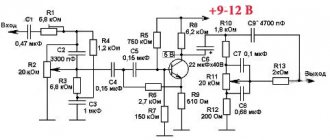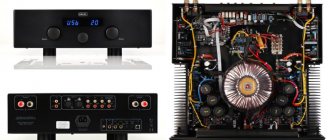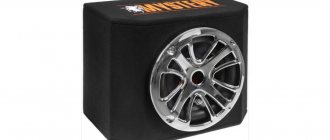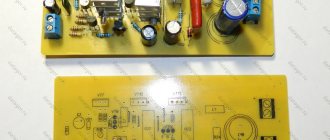ATC SCM11
Today I received a very interesting acoustics ATC SCM11 for testing. Why is she so interesting? First of all, by its design. ATC SCM11 is a small bookshelf speaker system with a closed cabinet design. The combination of modest dimensions and a closed housing alone is no longer typical in Hi-Fi and High-End equipment, but an even greater surprise was the use of a woofer with an elastic suspension designed for a long cone stroke. The fact is that in small-sized closed acoustic systems, the diffuser stroke is limited by the elasticity of the internal air volume and, accordingly, the use of a speaker with a long stroke seems at least strange, but let’s not draw hasty conclusions and let’s start listening.
The first thing I want to focus on is that the ATC SCM11 is a rather “tight” acoustics. Please note that it is not “bad”, but “tight”, these are not synonyms. It’s still worth paying attention to this fact, since to drive the ATC SCM11 you will need a fairly powerful amplifier. During the listening process, in order to achieve my usual volume level, I had to turn the amplifier knob to the 13 o'clock position, while the usual position with other acoustics is 10.5-11 o'clock. This absolutely should not alarm or frighten you, since the “stiffness” of the acoustics does not affect the quality of music reproduction; it only slightly complicates the initial process of choosing an amplifier, and in the future this problem will not bother you.
The closed cabinet slightly weakens the power of low frequencies, but at the same time adds elasticity to their sound. The tonal balance is evened out when using the ATC SCM11 in medium to small sized rooms. First of all, ATC SCM11 will appeal to fans of loud music listening, since with increasing volume the tonal balance is not disturbed, the bass does not begin to dominate and retains its articulation and elasticity. On top of that, as the volume increases, the potential of this extraordinary acoustics becomes more revealed. In addition, the closed housing of the acoustic systems eliminates the possibility of the appearance of bass-reflex overtones, therefore, the bass is reproduced more “correctly” and accurately, and at the same time, room resonances manifest themselves less.
The lucky owner of an ATC SCM11 will have to forget about the dream of owning a tube power amplifier, otherwise the low-frequency range will suffer. But if you think about it, the sound of the ATC SCM11 does not require tubes, since even without tubes in the path the sound is soft and pleasant, and the tones are clear and velvety. The absence of ringing in the sound of vocal parts significantly increases the realism of reproduction.
Despite their sufficient versatility, which the ATC SCM11 can boast no less than amplifiers from the same company, they still have a purpose. This purpose is music that contains frantic dynamics and drive, a deep and textured low-frequency pattern, music that requires volume and power. This does not mean at all that vocals and touching violin trills cannot give you pleasure and touch your soul; on the contrary, the ATC SCM11 can sound very soulful, but only if the volume is increased. At low volumes, it is quite difficult to unlock the recording potential with the ATC SCM11, but once you turn the amplifier knob, not many representatives of the same class can compare with them.
So who are the ATC SCM11 made for? For the owner of a small (about 15 sq.m.) listening room who has broad musical tastes, especially in the field of loud, heavy music with a complex relief bass pattern. Yes, perhaps the ATC SCM11 will not appeal to everyone, but for many it will be simply ideal.
Author: Maxim Shmelkov
DESIGN
The British company ATC (Acoustic Transducer Company) was founded in 1974 by Australian engineer Billy Woodman. The company was originally based in a suburb of London, but in 1985 it moved to the quieter town of Stroud in bucolic Gloucestershire.
The ATC brand is better known in the world of professional acoustics, and enjoys unquestioned authority in this environment. Her clients include BBC, CBS, EMI, Sony DVD and SACD Mastering in New York, Pioneer Mastering, Real World, Gateway Mastering, Pink Floyd, Naxos and TelArc, Todd AO, Paramount Pictures, Warner Brothers and many others . The number of companies using ATC equipment has long exceeded a thousand. For some time now, in addition to professional monitors, audio equipment: active speakers and their passive analogues, amplifiers. But the company’s strong point is still considered active acoustics, which best embodies Woodman’s principles.
As a young engineer who had just moved to England, Woodman set himself an ambitious goal - to combine the natural sound of the best hi-i loudspeakers of the time with the high dynamic range of horn loudspeakers. In addition, Woodman sought to make speakers with a wide polar pattern to create a large area of high-quality stereo effect for the listener.
None of the loudspeakers that existed on the market at that time met these requirements: for example, the English Rogers, which then served as the “court” monitors of the BBC, had natural sound, but had a limited dynamic range, and the American loudspeakers of those years had luxurious sound dynamics, but allowed take some tonal liberties.
Therefore, to realize his dream, Woodman had to conduct his own research, and after several years of work, he created his own mid-range speaker, equipped with a dome membrane made of paper with a viscous coating, which improves the damping properties of the diffuser. To increase the sensitivity of the speaker and control the direction of its radiation, a paper dome is placed in a shallow horn. Today, Woodman's horn-dome midrange driver is considered one of the best in the world, many manufacturers even try to copy its design.
ATS produces all parts of its loudspeakers, with the exception of tweeters and housings, in its own factory. Speaker bodies are made using ATC patterns by English furniture companies, and tweeters are purchased from well-known companies such as Vifa and Seas. Before leaving for storage, ATC loudspeakers are subjected to a rigorous test: they are tested with a “sweep” with a signal amplitude of 20 V. Having passed this test, the loudspeakers can safely operate in any studio or home theater system. In each pair of ATS speakers, sound parameters are maintained with high precision: for example, frequency characteristics are within 0.5 dB.
We tested the ATC SCM100ASL active speaker systems in the floor-standing version; these models also have passive options and active ones, but designed for installation on low racks. Traditionally, PBX loudspeakers are made in strictly rectangular, massive cabinets made of MDF, fastened inside with numerous ties. The facade of the speakers is additionally reinforced with a wooden slab several centimeters thick, the speakers are inserted into it - there are no decorative bells and whistles, the entire structure is reliable and extremely functional.
As far as we know, ATC designers deviated from this “classic” design only once, succumbing to the “pernicious” influence of fashion, they released the EL150 SLP models with oval-section cabinets. Below, the SCM100ASL cabinet is mounted on a low pedestal that barely protrudes beyond the boundaries of the main body. The number of available colors for ATC speakers is growing year by year; the SCM100ASL is veneered with yew, cherry, walnut and rosewood or finished in black.
The speakers are equipped with a Seas Excel series tweeter, equipped with a 25mm dome membrane, a silver voice coil and a dual neodymium magnet system. From 3.5 kHz, the same Woodman horn-dome midrange driver with a 75 mm diaphragm takes over the baton from the tweeter. The speaker uses a 75mm voice coil with a length of 3.5mm, suspended in a 5mm magnetic gap. The coil is surrounded by a massive magnetic system weighing 7.5 kg.
The clearance is a hundredth of an inch, which makes it possible to cool the coil with the magnet itself. ATC traditionally uses speakers with a short coil and a long magnetic gap - this combination ensures that the coil is always in the linear field region, even at maximum volume. As a result, the tonal balance of ATC speakers is weakly dependent on the level of emitted sound - a property that is extremely necessary in a professional studio, but it will not be superfluous in a home system either.
A speaker with a paper membrane with a diameter of 314 mm is responsible for reproducing frequencies below 380 Hz in the SCM100 ASL. The driver uses ATC's patented SLM (Super Liner Magnet) technology, developed by the company in 1986. The technology is designed to neutralize the appearance of eddy currents in the motor, which arise in the surface layer of the metal parts of the speaker and cause nonlinear sound distortion.
To suppress this unwanted effect, ATC replaced the thin layer of the magnet pole piece and surrounding areas with a special material called SLM, which is electrically insulating but permeable to magnetic fields. SLM has a complex structure: iron chips are suspended in the polymer, and the volume of the material is interspersed with oxide layers. As a result, the coil is not shielded from the magnetic field, but eddy currents in the SLM volume are suppressed.
Each speaker in the SCM100 ASL is driven by its own amplifier, the entire package is called Ampack and has a total power of 400 W: 50 W for the tweeter, 100 W for the midrange and 200 W for the midwoofer. The amplifier circuits in the automatic telephone exchange are developed by Woodman's partner Tim Isaac. He assembled his first prototype of three separate amplifiers for each band in 1985, since then the company's engineering staff has regularly improved the circuit.
Each monoblock amplifier is optimized to operate with a dedicated speaker, each monoblock has an isolated power supply, although the amplifiers are assembled on a single chassis to save space. All ATC amplifiers are based on MOSFET field-effect transistors and operate in pure class A up to 2/3 power.
The SCM100 ASL crossover uses proprietary Linkwitz-Riley 4th order coupling filters, also designed by Isaac. At the crossover frequencies, precise analog phase correction is carried out, so PBX speaker systems do not have equalization systems or built-in DSP; everything that is needed has already been done by engineers at the stage of assembling the active crossover.
Connection to a preamp or signal source is made using XLR connectors. The fully balanced input of the built-in amplifier allows you to connect speakers with cables up to 50 m long, although this feature of the speakers is unlikely to be useful at home.
MEASUREMENTS
SCM100 ASL acoustic systems demonstrate excellent frequency response linearity in the operating range of 40-20 kHz with characteristic unevenness of ±2.5 dB.
The angular homogeneity of the radiation is also excellent; the sensitivity curve in the 30° direction lies very close to the axial one with minimal level drop in the upper octave and in the region of the upper crossover point. The lower limit of ±3 dB was 34 Hz.
Graph of frequency response measured on the axis and at an angle of 30 degrees
The editors of the magazine “Consumer Video&Audio” thanks Nirovision
and the Fostergroup salon (metro Krasnye Vorota) for assistance in conducting the test.










